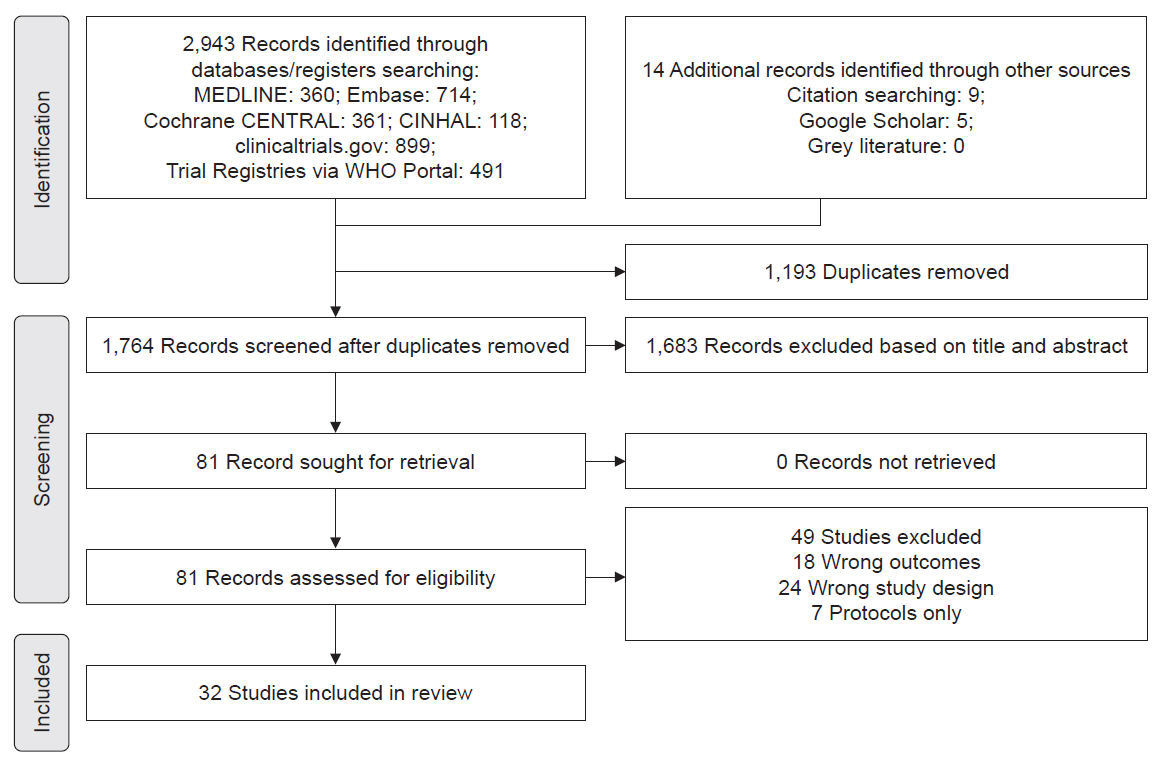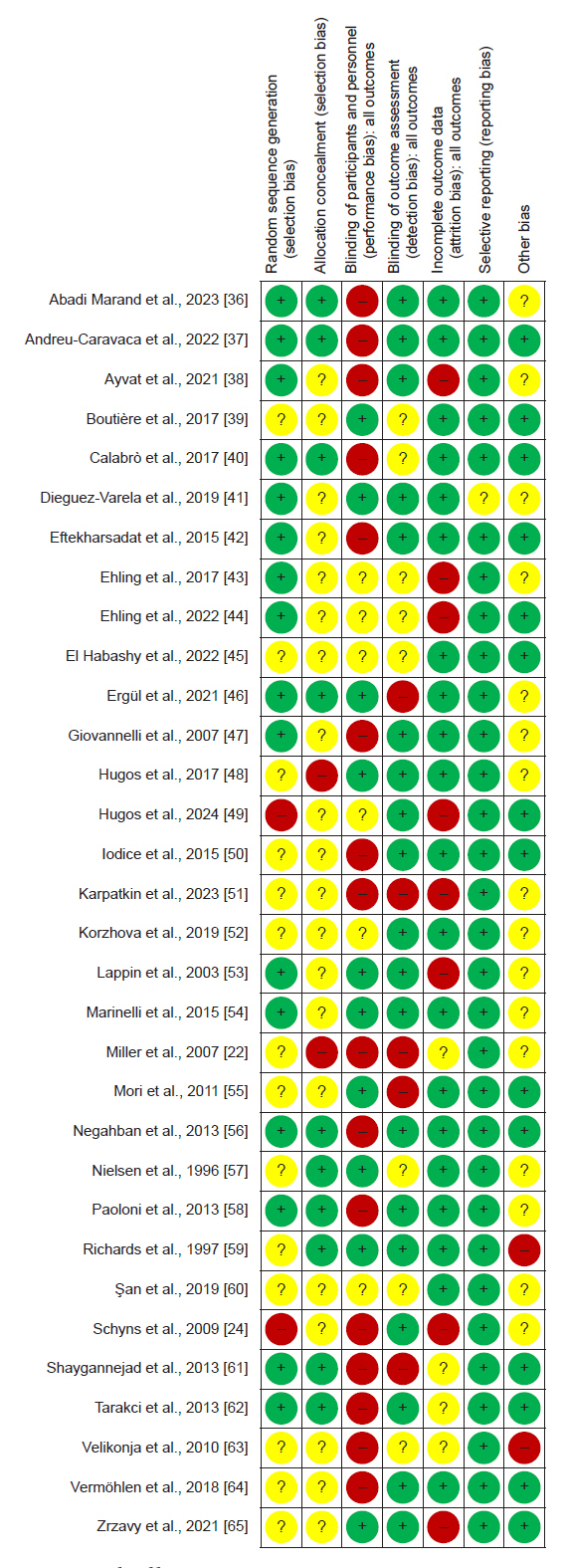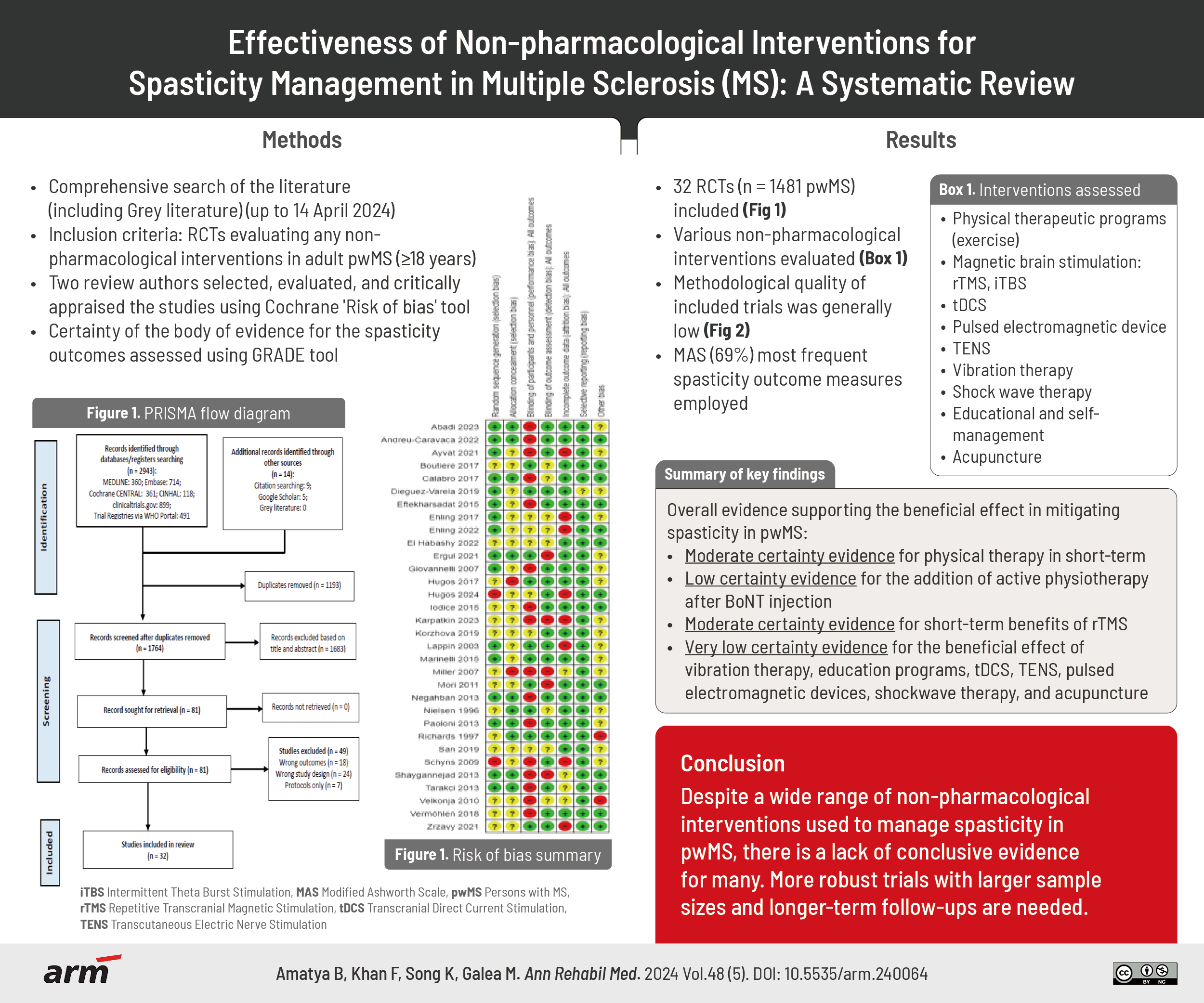Ann Rehabil Med.
2024 Oct;48(5):305-343. 10.5535/arm.240064.
Effectiveness of Non-Pharmacological Interventions for Spasticity Management in Multiple Sclerosis: A Systematic Review
- Affiliations
-
- 1Department of Rehabilitation Medicine, Royal Melbourne Hospital, Melbourne, Australia
- 2Department of Medicine, University of Melbourne, Melbourne, Australia
- 3Department of Rehabilitation, Peter MacCallum Cancer Centre, Parkville, Australia
- 4Australian Rehabilitation Research Centre, Royal Melbourne Hospital, Parkville, Australia
- KMID: 2560471
- DOI: http://doi.org/10.5535/arm.240064
Abstract
- This systematic review aims to determine the effectiveness of non-pharmacological interventions for the management of spasticity in people with multiple sclerosis (pwMS). A comprehensive literature search in health science databases (MEDLINE, Embase, CENTRAL, CINHAL) was performed to identify randomized controlled trials (RCTs) (up to April 2024). Manual searching in journals and screening of the reference lists of identified studies were conducted. Two authors independently selected the studies, assessed the methodological quality, and summarized the evidence. A meta-analysis was not feasible due to the methodological, clinical, and statistical diversity of the included studies. Overall, 32 RCTs (n=1,481 participants) investigated various types of non-pharmacological interventions including: physical activity, transcranial magnetic stimulation (intermittent theta burst stimulation [iTBS], repetitive transcranial magnetic stimulation [rTMS]), electromagnetic therapy, transcutaneous electrical nerve stimulation, vibration therapy, shock wave therapy, self-management educational programs, and acupuncture. All studies scored ‘low’ on the methodological quality assessment, implying a high risk of bias. The findings suggest ‘moderate to low certainty’ evidence for physical activity programs used in isolation or combination with other interventions (pharmacological or non-pharmacological), and for iTBS/rTMS with or without adjuvant exercise therapy in improving spasticity in adults with MS. There is ‘very low certainty’ evidence supporting the use of other modalities for treating spasticity in this population. Despite a wide range of non-pharmacological interventions used for the management of spasticity in pwMS, there is a lack of conclusive evidence for many. More robust trials with larger sample sizes and longer-term follow-ups are needed to build evidence for these interventions.
Figure
Reference
-
1. Walton C, King R, Rechtman L, Kaye W, Leray E, Marrie RA, et al. Rising prevalence of multiple sclerosis worldwide: insights from the Atlas of MS, third edition. Mult Scler. 2020; 26:1816–21.
Article2. Weinshenker BG, Bass B, Rice GP, Noseworthy J, Carriere W, Baskerville J, et al. The natural history of multiple sclerosis: a geographically based study. I. Clinical course and disability. Brain. 1989; 112(Pt 1):133–46.
Article3. Stevenson VL, Gras A, Bárdos JI, Broughton J. The high cost of spasticity in multiple sclerosis to individuals and society. Mult Scler. 2015; 21:1583–92.
Article4. Pandyan AD, Gregoric M, Barnes MP, Wood D, Van Wijck F, Burridge J, et al. Spasticity: clinical perceptions, neurological realities and meaningful measurement. Disabil Rehabil. 2005; 27:2–6.
Article5. Rizzo MA, Hadjimichael OC, Preiningerova J, Vollmer TL. Prevalence and treatment of spasticity reported by multiple sclerosis patients. Mult Scler. 2004; 10:589–95.
Article6. Lockley L, Buchanan K. Physical management of spasticity. In : Stevenson VL, Jarrett L, editors. Spasticity management : a practical multidisciplinary guide. Informa Healthcare;2006. p. 37–58.7. Sheean G. The pathophysiology of spasticity. In : Sheean G, editor. Spasticity rehabilitation. Churchill Communications;1998. p. 17–38.8. O'Dwyer NJ, Ada L. Reflex hyperexcitability and muscle contracture in relation to spastic hypertonia. Curr Opin Neurol. 1996; 9:451–5.9. Beard S, Hunn A, Wight J. Treatments for spasticity and pain in multiple sclerosis: a systematic review. Health Technol Assess. 2003; 7:iii, ix-x, 1–111.
Article10. World Health Organization (WHO). International Classification of Functioning, Disability and Health (ICF) [Internet]. WHO; 2001 [cited 2024 Apr 14]. Available from: https://www.who.int/standards/classifications/international-classification-of-functioning-disability-and-health.11. Hughes C, Howard IM. Spasticity management in multiple sclerosis. Phys Med Rehabil Clin N Am. 2013; 24:593–604.
Article12. Amatya B, Khan F, La Mantia L, Demetrios M, Wade DT. Non pharmacological interventions for spasticity in multiple sclerosis. Cochrane Database Syst Rev. 2013; CD009974.
Article13. Comi G, Solari A, Leocani L, Centonze D, Otero-Romero S; Italian Consensus Group on treatment of spasticity in multiple sclerosis. Italian consensus on treatment of spasticity in multiple sclerosis. Eur J Neurol. 2020; 27:445–53.
Article14. Fu X, Wang Y, Wang C, Wu H, Li J, Li M, et al. A mixed treatment comparison on efficacy and safety of treatments for spasticity caused by multiple sclerosis: a systematic review and network meta-analysis. Clin Rehabil. 2018; 32:713–21.
Article15. de Paiva A, Meunier FA, Molgó J, Aoki KR, Dolly JO. Functional repair of motor endplates after botulinum neurotoxin type A poisoning: biphasic switch of synaptic activity between nerve sprouts and their parent terminals. Proc Natl Acad Sci U S A. 1999; 96:3200–5.
Article16. Shakespeare DT, Young CA, Boggild M. Anti-spasticity agents for multiple sclerosis. Cochrane Database Syst Rev. 2000; 2003:CD001332.
Article17. Stevenson VL. Rehabilitation in practice: spasticity management. Clin Rehabil. 2010; 24:293–304.
Article18. Harned ME, Salles SS, Grider JS. An introduction to trialing intrathecal baclofen in patients with hemiparetic spasticity: a description of 3 cases. Pain Physician. 2011; 14:483–9.19. Henze T, Rieckmann P, Toyka KV; Multiple Sclerosis Therapy Consensus Group of the German Multiple Sclerosis Society. Symptomatic treatment of multiple sclerosis. Multiple Sclerosis Therapy Consensus Group (MSTCG) of the German Multiple Sclerosis Society. Eur Neurol. 2006; 56:78–105.20. Etoom M, Khraiwesh Y, Lena F, Hawamdeh M, Hawamdeh Z, Centonze D, et al. Effectiveness of physiotherapy interventions on spasticity in people with multiple sclerosis: a systematic review and meta-analysis. Am J Phys Med Rehabil. 2018; 97:793–807.
Article21. Su D, Wang A, Zhu M, Yang F, Li W, Ma B, et al. Repetitive transcranial magnetic stimulation for treatment of limb spasticity following multiple sclerosis: a systematic review and meta-analysis. Braz J Med Biol Res. 2023; 56:e12708.
Article22. Miller L, Mattison P, Paul L, Wood L. The effects of transcutaneous electrical nerve stimulation (TENS) on spasticity in multiple sclerosis. Mult Scler. 2007; 13:527–33.
Article23. Mills PB, Dossa F. Transcutaneous electrical nerve stimulation for management of limb spasticity: a systematic review. Am J Phys Med Rehabil. 2016; 95:309–18.24. Schyns F, Paul L, Finlay K, Ferguson C, Noble E. Vibration therapy in multiple sclerosis: a pilot study exploring its effects on tone, muscle force, sensation and functional performance. Clin Rehabil. 2009; 23:771–81.
Article25. Haselkorn JK, Balsdon Richer C, Fry Welch D, Herndon RM, Johnson B, Little JW, Multiple Sclerosis Council for Clinical Practice Guidelines, et al. Overview of spasticity management in multiple sclerosis. Evidence-based management strategies for spasticity treatment in multiple sclerosis. J Spinal Cord Med. 2005; 28:167–99.26. Alashram AR, Janada Q, Ghrear T. Noninvasive brain stimulation for spasticity rehabilitation in multiple sclerosis: a systematic review of randomized controlled trials. PM R. 2024; 16:268–77.
Article27. Chen X, Yin L, An Y, Yan H, Zhang T, Lu X, et al. Effects of repetitive transcranial magnetic stimulation in multiple sclerosis: a systematic review and meta-analysis. Mult Scler Relat Disord. 2022; 59:103564.
Article28. Khan F, Amatya B, Bensmail D, Yelnik A. Non-pharmacological interventions for spasticity in adults: an overview of systematic reviews. Ann Phys Rehabil Med. 2019; 62:265–73.
Article29. Page MJ, McKenzie JE, Bossuyt PM, Boutron I, Hoffmann TC, Mulrow CD, et al. The PRISMA 2020 statement: an updated guideline for reporting systematic reviews. BMJ. 2021; 372:n71.30. McDonald WI, Compston A, Edan G, Goodkin D, Hartung HP, Lublin FD, et al. Recommended diagnostic criteria for multiple sclerosis: guidelines from the International Panel on the diagnosis of multiple sclerosis. Ann Neurol. 2001; 50:121–7.
Article31. Polman CH, Reingold SC, Edan G, Filippi M, Hartung HP, Kappos L, et al. Diagnostic criteria for multiple sclerosis: 2005 revisions to the “McDonald Criteria”. Ann Neurol. 2005; 58:840–6.
Article32. Poser CM, Paty DW, Scheinberg L, McDonald WI, Davis FA, Ebers GC, et al. New diagnostic criteria for multiple sclerosis: guidelines for research protocols. Ann Neurol. 1983; 13:227–31.
Article33. Higgins JPT, Thomas J, Chandler J, Cumpston M, Li T, Page MJ, et al. Cochrane handbook for systematic reviews of interventions version 6.4 [Internet]. Cochrane; 2023 [cited 2024 Apr 10]. Available from: www.training.cochrane.org/handbook.34. Review Manager (RevMan). Review Manager Web (RevMan Web). Version 8.1.1 [Internet]. The Cochrane Collaboration; 2024 [cited 2024 Mar 14]. Available from: https://training.cochrane.org/online-learning/core-software/revman.35. Balshem H, Helfand M, Schünemann HJ, Oxman AD, Kunz R, Brozek J, et al. GRADE guidelines: 3. Rating the quality of evidence. J Clin Epidemiol. 2011; 64:401–6.
Article36. Abadi Marand L, Noorizadeh Dehkordi S, Roohi-Azizi M, Dadgoo M. Effect of dynamic neuromuscular stabilization on balance, trunk function, falling, and spasticity in people with multiple sclerosis: a randomized controlled trial. Arch Phys Med Rehabil. 2023; 104:90–101.
Article37. Andreu-Caravaca L, Ramos-Campo DJ, Chung LH, Rubio-Arias JÁ. Can strength training modify voluntary activation, contractile properties and spasticity in multiple sclerosis?: a randomized controlled trial. Physiol Behav. 2022; 255:113932.
Article38. Ayvat F, Özçakar L, Ayvat E, Aksu Yıldırım S, Kılınç M. Effects of low vs. high frequency local vibration on mild-moderate muscle spasticity: ultrasonographical and functional evaluation in patients with multiple sclerosis. Mult Scler Relat Disord. 2021; 51:102930.
Article39. Boutière C, Rey C, Zaaraoui W, Le Troter A, Rico A, Crespy L, et al. Improvement of spasticity following intermittent theta burst stimulation in multiple sclerosis is associated with modulation of resting-state functional connectivity of the primary motor cortices. Mult Scler. 2017; 23:855–63.
Article40. Calabrò RS, Russo M, Naro A, De Luca R, Leo A, Tomasello P, et al. Robotic gait training in multiple sclerosis rehabilitation: can virtual reality make the difference? Findings from a randomized controlled trial. J Neurol Sci. 2017; 377:25–30.
Article41. Dieguez-Varela C, Lion-Vazquez S, Fraga-Bau A, Rodriguez-Acevedo B, Rodriguez-Sanchez L, Collazo-Dieguez M, et al. [Intermittent theta-burst transcranial magnetic stimulation for the treatment of spasticity in patients with recurring multiple sclerosis: the results of a double-blind randomised clinical trial]. Rev Neurol. 2019; 69:45–52. Spanish.42. Eftekharsadat B, Babaei-Ghazani A, Mohammadzadeh M, Talebi M, Eslamian F, Azari E. Effect of virtual reality-based balance training in multiple sclerosis. Neurol Res. 2015; 37:539–44.
Article43. Ehling R, Edlinger M, Hermann K, Dröge K, Seidinger Y, Miller U, et al. Successful long-term management of spasticity in patients with multiple sclerosis using a software application (APP): a pilot study. Mult Scler Relat Disord. 2017; 17:15–21.
Article44. Ehling R, Seebacher B, Harsányi A, Ganzbiller N, Papez S, Haider B, et al. Successful long-term management of spasticity in people with multiple sclerosis using a software application: results from a randomized, controlled, multicenter study. Eur J Neurol. 2022; 29:1697–707.
Article45. El Habashy HR, El Sawy N, Al Menabbawy S, Dahshan A. Transcranial direct current stimulation for spasticity in patients with multiple sclerosis: exploring novel routes. Mult Scler Relat Disord. 2022; 67:104191.
Article46. Ergül M, Nodehi Moghadam A, Bıglarıan A. Effects of static and functional stretching exercises on lower limb spasticity and function in people with multiple sclerosis: a randomized controlled trial. Turk J Physiother Rehabil. 2021; 32:43–51.
Article47. Giovannelli M, Borriello G, Castri P, Prosperini L, Pozzilli C. Early physiotherapy after injection of botulinum toxin increases the beneficial effects on spasticity in patients with multiple sclerosis. Clin Rehabil. 2007; 21:331–7.
Article48. Hugos CL, Bourdette D, Chen Y, Chen Z, Cameron M. A group-delivered self-management program reduces spasticity in people with multiple sclerosis: a randomized, controlled pilot trial. Mult Scler J Exp Transl Clin. 2017; 3:2055217317699993.
Article49. Hugos CL, Joos SK, Perumean-Chaney SE, Cutter GR, Cameron MH. Stretching is not essential for managing MS spasticity: a randomized controlled trial. Mult Scler. 2024; 30:89–102.
Article50. Iodice R, Dubbioso R, Ruggiero L, Santoro L, Manganelli F. Anodal transcranial direct current stimulation of motor cortex does not ameliorate spasticity in multiple sclerosis. Restor Neurol Neurosci. 2015; 33:487–92.
Article51. Karpatkin H, Siminovich-Blok B, Rachwani J, Langer Z, Winsor S. Effect of acupuncture on sensorimotor function and mobility in patients with multiple sclerosis: a pilot study. J Integr Complement Med. 2023; 29:42–9.
Article52. Korzhova J, Bakulin I, Sinitsyn D, Poydasheva A, Suponeva N, Zakharova M, et al. High-frequency repetitive transcranial magnetic stimulation and intermittent theta-burst stimulation for spasticity management in secondary progressive multiple sclerosis. Eur J Neurol. 2019; 26:680–e44.
Article53. Lappin MS, Lawrie FW, Richards TL, Kramer ED. Effects of a pulsed electromagnetic therapy on multiple sclerosis fatigue and quality of life: a double-blind, placebo controlled trial. Altern Ther Health Med. 2003; 9:38–48.54. Marinelli L, Mori L, Solaro C, Uccelli A, Pelosin E, Currà A, et al. Effect of radial shock wave therapy on pain and muscle hypertonia: a double-blind study in patients with multiple sclerosis. Mult Scler. 2015; 21:622–9.
Article55. Mori F, Ljoka C, Magni E, Codecà C, Kusayanagi H, Monteleone F, et al. Transcranial magnetic stimulation primes the effects of exercise therapy in multiple sclerosis. J Neurol. 2011; 258:1281–7.
Article56. Negahban H, Rezaie S, Goharpey S. Massage therapy and exercise therapy in patients with multiple sclerosis: a randomized controlled pilot study. Clin Rehabil. 2013; 27:1126–36.
Article57. Nielsen JF, Sinkjaer T, Jakobsen J. Treatment of spasticity with repetitive magnetic stimulation; a double-blind placebo-controlled study. Mult Scler. 1996; 2:227–32.
Article58. Paoloni M, Giovannelli M, Mangone M, Leonardi L, Tavernese E, Di Pangrazio E, et al. Does giving segmental muscle vibration alter the response to botulinum toxin injections in the treatment of spasticity in people with multiple sclerosis? A single-blind randomized controlled trial. Clin Rehabil. 2013; 27:803–12.
Article59. Richards TL, Lappin MS, Acosta-Urquidi J, Kraft GH, Heide AC, Lawrie FW, et al. Double-blind study of pulsing magnetic field effects on multiple sclerosis. J Altern Complement Med. 1997; 3:21–9.
Article60. Şan AU, Yılmaz B, Kesikburun S. The effect of repetitive transcranial magnetic stimulation on spasticity in patients with multiple sclerosis. J Clin Neurol. 2019; 15:461–7.
Article61. Shaygannejad V, Janghorbani M, Vaezi A, Haghighi S, Golabchi K, Heshmatipour M. Comparison of the effect of baclofen and transcutaneous electrical nerve stimulation for the treatment of spasticity in multiple sclerosis. Neurol Res. 2013; 35:636–41.
Article62. Tarakci E, Yeldan I, Huseyinsinoglu BE, Zenginler Y, Eraksoy M. Group exercise training for balance, functional status, spasticity, fatigue and quality of life in multiple sclerosis: a randomized controlled trial. Clin Rehabil. 2013; 27:813–22.
Article63. Velikonja O, Curić K, Ozura A, Jazbec SS. Influence of sports climbing and yoga on spasticity, cognitive function, mood and fatigue in patients with multiple sclerosis. Clin Neurol Neurosurg. 2010; 112:597–601.
Article64. Vermöhlen V, Schiller P, Schickendantz S, Drache M, Hussack S, Gerber-Grote A, et al. Hippotherapy for patients with multiple sclerosis: a multicenter randomized controlled trial (MS-HIPPO). Mult Scler. 2018; 24:1375–82.
Article65. Zrzavy T, Pfitzner A, Flachenecker P, Rommer P, Zettl UK. Effects of normobaric hypoxic endurance training on fatigue in patients with multiple sclerosis: a randomized prospective pilot study. J Neurol. 2021; 268:4809–15.
Article66. Amatya B, Khan F, Galea M. Rehabilitation for people with multiple sclerosis: an overview of Cochrane Reviews. Cochrane Database Syst Rev. 2019; 1:CD012732.
Article67. Leavitt VM, Wylie G, Chiaravalloti N, DeLuca J, Sumowski JF. Warmer outdoor temperature is associated with task-related increased BOLD activation in patients with multiple sclerosis. Brain Imaging Behav. 2014; 8:128–32.
Article68. Fleuren JF, Voerman GE, Erren-Wolters CV, Snoek GJ, Rietman JS, Hermens HJ, et al. Stop using the Ashworth Scale for the assessment of spasticity. J Neurol Neurosurg Psychiatry. 2010; 81:46–52.
Article69. Hobart JC, Riazi A, Thompson AJ, Styles IM, Ingram W, Vickery PJ, et al. Getting the measure of spasticity in multiple sclerosis: the Multiple Sclerosis Spasticity Scale (MSSS-88). Brain. 2006; 129(Pt 1):224–34.
Article70. Ergul M, Nodehi Moghadam A, Soh R. The effectiveness of interventions targeting spasticity on functional clinical outcomes in patients with multiple sclerosis: a systematic review of clinical trials. Eur J Physiother. 2020; 24:21–9.
Article71. León Ruiz M, Sospedra M, Arce Arce S, Tejeiro-Martínez J, Benito-León J. Current evidence on the potential therapeutic applications of transcranial magnetic stimulation in multiple sclerosis: a systematic review of the literature. Neurologia (Engl Ed). 2022; 37:199–215.
Article72. Pandyan AD, Johnson GR, Price CI, Curless RH, Barnes MP, Rodgers H. A review of the properties and limitations of the Ashworth and modified Ashworth Scales as measures of spasticity. Clin Rehabil. 1999; 13:373–83.
Article73. Sheean G. The pathophysiology of spasticity. Eur J Neurol. 2002; 9 Suppl 1:3–9; dicussion 53-61.
Article74. Ward AB, Aguilar M, De Beyl Z, Gedin S, Kanovsky P, Molteni F, et al. Use of botulinum toxin type A in management of adult spasticity--a European consensus statement. J Rehabil Med. 2003; 35:98–9.75. Egger M, Smith GD. Bias in location and selection of studies. BMJ. 1998; 316:61–6.76. Gøtzsche PC. Reference bias in reports of drug trials. Br Med J (Clin Res Ed). 1987; 295:654–6.
Article77. Lefaucheur JP, Aleman A, Baeken C, Benninger DH, Brunelin J, Di Lazzaro V, et al. Evidence-based guidelines on the therapeutic use of repetitive transcranial magnetic stimulation (rTMS): an update (2014-2018). Clin Neurophysiol. 2020; 131:474–528.
Article78. Bennett MI, Closs SJ. Methodological issues in nonpharmacological trials for chronic pain. Anaesth Pain Intensive Care. 2011; 15:126–32.
- Full Text Links
- Actions
-
Cited
- CITED
-
- Close
- Share
- Similar articles
-
- Effectiveness of non-pharmacological interventions to reduce internalized stigma in people with severe mental illness: a systematic review and meta-analysis
- The Efficacy of Spinal Cord Stimulators in the Reduction of Multiple Sclerosis Spasticity: A Narrative Systematic Review
- Effectiveness of Non-pharmacological Interventions for Adolescents With Type 1 Diabetes in the Last Five Years: A Systematic Review and Meta-analysis
- Non-pharmacological Intervention for Wandering Behavior in Dementia: A Systematic Review and Meta-analysis
- Effectiveness of Non-Pharmacological Interventions on Gaming Disorder: A Systematic Review and Meta-Analysis





